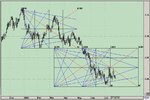Not sure how helpful this will be.
The first chart is EURUSD Daily with 2 Gann Fans in MetaStock with the Red fan showing the 'nodes'.
MS Help:
" Gann Angles are drawn between a significant bottom and top (or vice versa) at various angles. Deemed the most important by Gann, the 1 x 1 trendline signifies a bull market if prices are above the trendline or a bear market if below. Gann felt that a 1*x*1 trendline provides major support during an up-trend and when the trendline is broken, it signifies a major reversal in the trend. Gann identified nine significant angles, with the 1 x 1 being the most important:
1 x 8 - 82.5 degrees 1 x 4 - 75 degrees 1 x 3 - 71.25 degrees 1 x 2 - 63.75 degrees
1 x 1 - 45 degrees 2 x 1 - 26.25 degrees 3 x 1 - 18.75 degrees 4 x 1 - 15 degrees
8 x 1 - 7.5 degrees
Note that in order for the rise/run values (e.g., 1 x 1, 1 x 8, etc.) to match the actual angles (in degrees), the x- and y-axes must have equally spaced intervals. This means that one unit on the x-axis (i.e., hour, day, week, month, etc.) must be the same distance as one unit on the y-axis. The easiest way to calibrate the chart is make sure that a 1 x 1 angle produces a 45 degree angle.
Gann observed that each of the angles can provide support and resistance depending on the trend. For example, during an up-trend the 1*x*1 angle tends to provide major support. A major reversal is signaled when prices fall below the 1 x 1 angled trendline. According to Gann, prices should then be expected to fall to the next trendline (i.e., the 2 x 1 angle). In other words, as one angle is penetrated, expect prices to move and consolidate at the next angle. "
Second chart is from Advanced GET showing the Gann Box. Using 'fixed increments', different sized boxes can be drawn and a small box has been used to illustrate what I believe to be the box's superiority to the fan. Besides Advanced GET, Ensign Software has a Gann Square, see Newsletter scroll down to Tools:
http://www.ensignsoftware.com/
AG Help:
" The Gann Box can be used in a variety of individual ways. One recommended method of drawing the Gann Box is to take the previous Major Pivot point (usually the end of the last 5 Wave sequence) and draw it so that the 1 X 1 line follows the current market support areas to a good degree. This is a very subjective method of drawing the Gann Box, but experience will teach you the best origin for the Gann Box. Also, try using in conjunction with Auto GANN Angles.
Menu Functions: The Colors selection list allows you to change the color of the 1 X 4, 1 X 2, 1 X 1, 2 X 1, and 4 X 1 lines that comprise the Gann Box.
The Scaling: selection list allows you to choose between a Gann Box made using Fixed Increments for scaling and a Gann Box drawn using a Free Form scaling. The Fixed Increments scaling is used when you want the Gann Box to be drawn with the computer generated fixed interval patterns that are built into GET. This is the setting that is most often used by the individuals at Trading Techniques, Inc. The Free Form scaling should be used when you want the Gann Box to be drawn at any scale and in any increment that you want. With the Free Form scaling, you have total control on the size of the box.
" . . . uses the Gann Box from a major pivot, he then makes the 1 X 1 line plot near the trading opportunity, and he makes sure to plot the box in 45 bar increments 45, 90, 135, 180, 225. The number on the top left is the points from the bottom of the box, and the number in the lower right is the bars from the start of the box to square."




